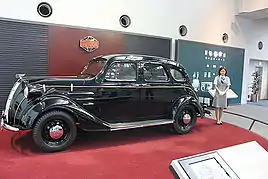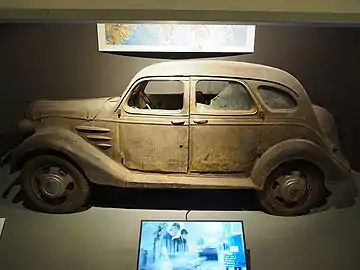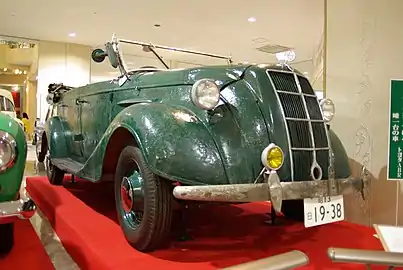Toyota AA
The A1 was the first prototype passenger car built by the company that became Toyota. It was redesigned and put into production as Toyota's first production cars, the AA sedan and the AB cabriolet. These were succeeded by the similar AE, AC and BA sedans.

The series as a whole was replaced by the quite different and much more advanced SA.
A1
| Toyota A1 | |
|---|---|
| Overview | |
| Manufacturer | Toyota |
| Production | 1935 (3 prototypes) |
| Assembly | Koromo, Japan |
| Body and chassis | |
| Class | Medium size family car |
| Body style | Sedan |
| Layout | FR layout |
| Related | Toyota G1 |
| Powertrain | |
| Engine | 3.4L Type A I6 |
| Transmission | 3-speed manual |
| Chronology | |
| Successor | Toyota AA |
Three A1 prototypes were completed in May 1935. None of them survive. They were blessed in a Buddhist ceremony and Kiichiro Toyoda then drove one of them to his father's grave (his father having given him the seed money to start a car factory).
After completion of the prototypes, Toyota then switched its attention to the G1 truck because it was more likely to be profitable in the short term. After the G1 was in production the company was able to spend resources on developing the AA and AB passenger cars.
Dates
The A1 prototypes were completed in May 1935.
Mechanicals
The A1 used the 3,389 cc (206.8 cu in) Type A Overhead valve 6-cylinder engine producing 62 horsepower (46 kW) with a 3-speed column-shift manual gearbox.
The Type A engine was copied from a purchased and reverse engineered 1933 Chevrolet Master, and the chassis and electrics were copied from Ford.[1]
Solid axles were used at both ends. Pressed metal discs were used for all 4 wheel rims (very modern for the time). Braking was by drums.
The mechanicals were the same as used in the production AA, AB and G1 vehicles.
Body
The A1 was a fully enclosed, 4-door sedan, with conventional front-hinged front doors and rear-hinged suicide-style rear doors. It was heavily based on the Chrysler built DeSoto Airflow, which was a reflection of Art Deco and streamlined appearances.[2] Toyoda bought an Airflow and disassembled it the year before producing the A1. The front window was a single piece of flat glass with a top-mounted wiper on the driver's side. There were 3 windows per side, one for the front door (without a quarter light window), one for the rear door and one behind the rear door. A spare tyre was mounted on the nearly vertical boot lid.
The A1 was available only as a right-hand-drive vehicle.
AA/AB
| Toyota AA/Toyota AB | |
|---|---|
 | |
| Overview | |
| Manufacturer | Toyota |
| Production | 1936–1943 |
| Assembly | Koromo, Japan |
| Body and chassis | |
| Class | Mid-size car |
| Body style | 4-door sedan (AA) 4-door convertible (AB) |
| Layout | Front-engine, rear-wheel-drive |
| Related | Ford Sedan |
| Powertrain | |
| Engine | 3.4 L Type A I6 (original) 2.3 L 2M I6 (reproduction) |
| Transmission | 3-speed manual |
| Dimensions | |
| Wheelbase | 2,851 mm (112.2 in)[3] |
| Length | 4,737 mm (186.5 in) |
| Width | 1,734 mm (68.3 in) |
| Height | 1,737 mm (68.4 in) |
| Curb weight | 1,500 kg (3,307 lb) |
| Chronology | |
| Predecessor | Toyota A1 |
| Successor | Toyota AC |
The AA was similar to the A1 prototypes with only minor changes.
Dates and production figures
A total of 1,404 AA sedans were produced from 1936 to 1943, when the model was replaced by the more austere AC.
A total of 353 AB convertible, including the military ABR version, was produced from 1936 to 1942. There was no direct replacement.
Body types
The AA was a fully enclosed 4-door sedan that largely copied the design of the Chrysler built DeSoto Airflow. It had a metal body on a metal ladder chassis. The metal body was of modern construction compared to the fabric-over-wooden-frame bodies used on cars designed in the 1920s. The rear doors opened backwards as suicide doors. The front glass spanned the entire width of the body in a single pane.
The AB was identical to the AA except that it was a convertible with a folding cloth roof, the rear doors opened forwards like conventional doors and the front glass could fold down onto the engine compartment.
Mechanicals
The mechanicals were the same as used in the A1 prototype.
50th year replica
Toyota wanted to use an AA for its 50th birthday in 1987 but couldn't find any surviving examples.[4] Toyota decided to build a replica but even for that there were no complete and consistent plans. Plans that could be found were from various points during the car's development process and in any case were often incomplete and lacking by today's standards. However, a single replica was built that is believed to be representative of the AA. This replica is now in the Toyota Automobile Museum.
Discovery of the oldest known AA
In 2008 an original AA was found in Russia in derelict and heavily modified condition, with undercarriage and drivetrain from a GAZ-51 truck. It is now displayed, still in this condition, in the Louwman Museum in the Netherlands.[5][6]
 Model AA at the Louwman Museum
Model AA at the Louwman Museum 1936 Model AB Convertible
1936 Model AB Convertible 1938 Model ABR
1938 Model ABR
AC
| Toyota AC | |
|---|---|
 | |
| Overview | |
| Manufacturer | Toyota |
| Production | 1943–1944, 1947-1948 |
| Body and chassis | |
| Class | Medium size family car |
| Body style | 4-door sedan |
| Layout | FR layout |
| Powertrain | |
| Engine | 3.4L Type B I6 |
| Transmission | 3-speed manual |
| Dimensions | |
| Wheelbase | 2,850 mm (112.2 in)[3] |
| Length | 4,884 mm (192.3 in) |
| Width | 1,734 mm (68.3 in) |
| Height | 1,746 mm (68.7 in) |
| Curb weight | 1,550 kg (3,417.2 lb) |
| Chronology | |
| Predecessor | Toyota AA & AB |
| Successor | Toyota SA |
The AC was similar to the AA, with only minor alternations to the body. The front glass was now a split into left and right halves with thick metal body work between them.
Dates and production figures
Design work began in 1938. A total of 115 AC sedans was produced from 1943 until the model was replaced by the Toyota SA during 1947–1948. Forty-three were produced in 1943, 19 in 1944 (until February), and 50 units were made from spares in 1947 for a military order, with a final three being built in 1948. No Toyota passenger car production occurred in the years 1945 and 1946, although what would become the first post-war car, the SA, was in development during these years.
Mechanicals
The mechanicals were similar to the AA and AB.
EA
| Toyota EA | |
|---|---|
| Overview | |
| Manufacturer | Toyota |
| Production | 1938 (prototypes) |
| Assembly | Koromo, Japan |
| Body and chassis | |
| Class | Subcompact family car |
| Body style | 2-door saloon |
| Layout | FF layout |
| Related | DKW F7 |
| Powertrain | |
| Engine | 585 cc Type E I2 two-stroke |
| Dimensions | |
| Wheelbase | 2,610 mm (102.8 in) [3] |
| Length | 3,220 mm (126.8 in) |
| Width | 1,300 mm (51.2 in) |
| Height | 1,250 mm (49.2 in) |
| Curb weight | 650 kg (1,433 lb) |
Kiichiro Toyoda designed the EA as a copy of the DKW F7 sedan in 1938 but production was prevented by war time restrictions.[3]
Dates and production figures
The EA was designed in 1938 but did not go into production.
Mechanicals
A small front-mounted, 2-cylinder, 2-stroke Type E engine connected as front-wheel drive.
EB
The EB was a RWD minicar, but production was prevented by wartime restrictions.[7]
Dates and production figures
The EB was designed in 1938 but did not go into production.
Mechanicals
A small front-mounted, 2-cylinder, 2-stroke Type E engine connected as rear-wheel drive.
AE
| Toyota AE | |
|---|---|
| Overview | |
| Manufacturer | Toyota |
| Production | 1941–1943 |
| Body and chassis | |
| Class | medium size family car |
| Body style | sedan |
| Layout | FR layout |
| Powertrain | |
| Engine | 2.3L Type C I4 |
| Transmission | 3-speed manual |
| Dimensions | |
| Wheelbase | 2,500 mm (98.4 in)[3] |
| Length | 4,500 mm (177.2 in) |
| Width | 1,730 mm (68.1 in) |
| Height | 1,635 mm (64.4 in) |
| Curb weight | 1,220 kg (2,689.6 lb) |
| Chronology | |
| Predecessor | AA, AB |
| Successor | AC |
The AE sedan was a smaller car than its predecessors.
Dates and production figures
The AE was developed during 1939, and a prototype was completed in September of that year. The model was introduced at the beginning of 1940. However, production occurred from 1941 to 1943. Only 76 of this model were built.[8][9]
Mechanicals
The mechanicals were similar to the AA except that it had the Type C engine, which was a Type A with 2 cylinders removed.
BA
The BA was an austerity sedan, and used wood in its framing to conserve metal. This model is said to have been based on the Volvo PV60,[8][10] but this is open to question, since the PV60 was not introduced until 1944, and did not enter production until 1946. Most of the prototypes of this Volvo were built in the 1942–1944 period. There is anecdotal information regarding a 1939 PV60 prototype, but the data is sketchy and no photos exist.[11]
Dates and production figures
The BA was introduced and first produced in 1940. No more than 17 were built.[9] Some sources, however, claim the model did not enter production, such as it was, until 1943, with one giving the date of June 1943.[8][10] But judging from 1943's production figures, the majority of which would have to represent the AC, it would not seem to be the case that all 17 BA production cars were built that year. The production of the 17 cars may have occurred in 1940 and 1943, or perhaps it was stretched over the 1940–1943 period, with the last few being completed in 1943, when the model was said to have started "official" production. Support for the notion that at least a few of these cars were produced in 1943 would come from a photograph (obtained from Toyota Motor Co. Ltd.) of a BA captioned as "1943 Totoya Model BA 4-cylinder saloon" in at least one source.[12]
Other prototypes never built in series
One example of the Model BB phaeton was built, in 1941.[9] It resembled a contemporary Chevrolet.
Two[9] or three[13] examples of a luxury sedan, known as the Model B (or Model BC, according to one source[14]), were built. Although one source associates this model with the year 1942,[13] most claim the prototypes were built in 1944.[8][10][14] This was the last passenger car development until after the war ended.
Toyota passenger car production from 1935 to 1949
The following table is a portion of that put out by Toyota, and represents passenger car production only, apparently not including prototypes:
| 1935 | 1936 | 1937 | 1938 | 1939 | 1940 | 1941 | 1942 | 1943 | 1944 | 1945 | 1946 | 1947 | 1948 | 1949 |
|---|---|---|---|---|---|---|---|---|---|---|---|---|---|---|
References
- "Toyota-fifty years in motion", Eiji Toyoda, Tokyo: Kodansha International, 1987.
- "Against all odds", Yukiyasu Togo & William Wartman, New York: St. Martin's Press, 1993, ISBN 0-312-09733-6, p56-73
- "Autos Made in Japan", Jan P. Norbye, Gerlingen: Bleicher Verlag, 1991, ISBN 3-88350-161-1
- Toyota history web page, 1867–1939, http://www.toyota.co.jp/en/history/1867.html
- Toyota history web page, 1940–1949, http://www.toyota.co.jp/en/history/1940.html
- Sapienza, James Derek (2017-03-20). "Toyota AA: Meet the World's Oldest Toyota". Autos Cheat Sheet. Retrieved 2017-08-08.
- 1934 De Soto Airflow Series SE, Toyota Automobile Museum, retrieved 22 December 2014
- "The Japanese Automobile Industry: Technology and Management at Nissan & Toyota", Michael Cusumano, Cambridge (Mass.) & London: The Harvard Univ. Press, 1985, ISBN 0-674-47256-X
- "The Toyota AA Passenger Car". the wheel extended. 17 (3): 48–49. 1987.
- "Russian Toyota AA Surfaces in The Netherlands". japanesenostalgiccar.com. July 2010. Archived from the original on 2010-07-15. Retrieved 2010-10-20.
- "Louwman Museum" (in Dutch). Retrieved 2015-06-15.
- Toyota: A history of the First 50 Years. Toyota Motor Corporation. 1988. p. 133/135/137. ISBN 0-517-61777-3.
- "One Hundred Years of the Automobile, 1886–1986", Marco Ruiz (editor), New York: Gallery Books, 1985, ISBN 0-8317-6550-X
- "Japan's Toyota with Stovebolts", Bob Hall, in "Special-Interest Autos", Mar-Apr 1977
- "The Complete History of the Japanese Car", Marco Ruiz, New York: Portland House, 1986, ISBN 0-517-61777-3
- "Volvo: The Cars -- From the 20s to the 80's", Björn-Eric Lindh, Malmö: Förlagshuset Norden AB, 1986, ISBN 91-86442-14-7
- "The Complete Encyclopedia of Motorcars: 1885 to the Present", G.N. Georgano, New York: E. P. Dutton, 2nd edition, 1973, ISBN 0-525-08351-0
- "Toyota seit 1936", Joachim Kuch, Stuttgart: Motorbuch Verlag, Artikelnummer 17060
- "The Beaulieu Encyclopedia of the Automobile", G.N. Georgano, Norwich: The Stationery Office Limited, 2000, ISBN 1-57958-293-1